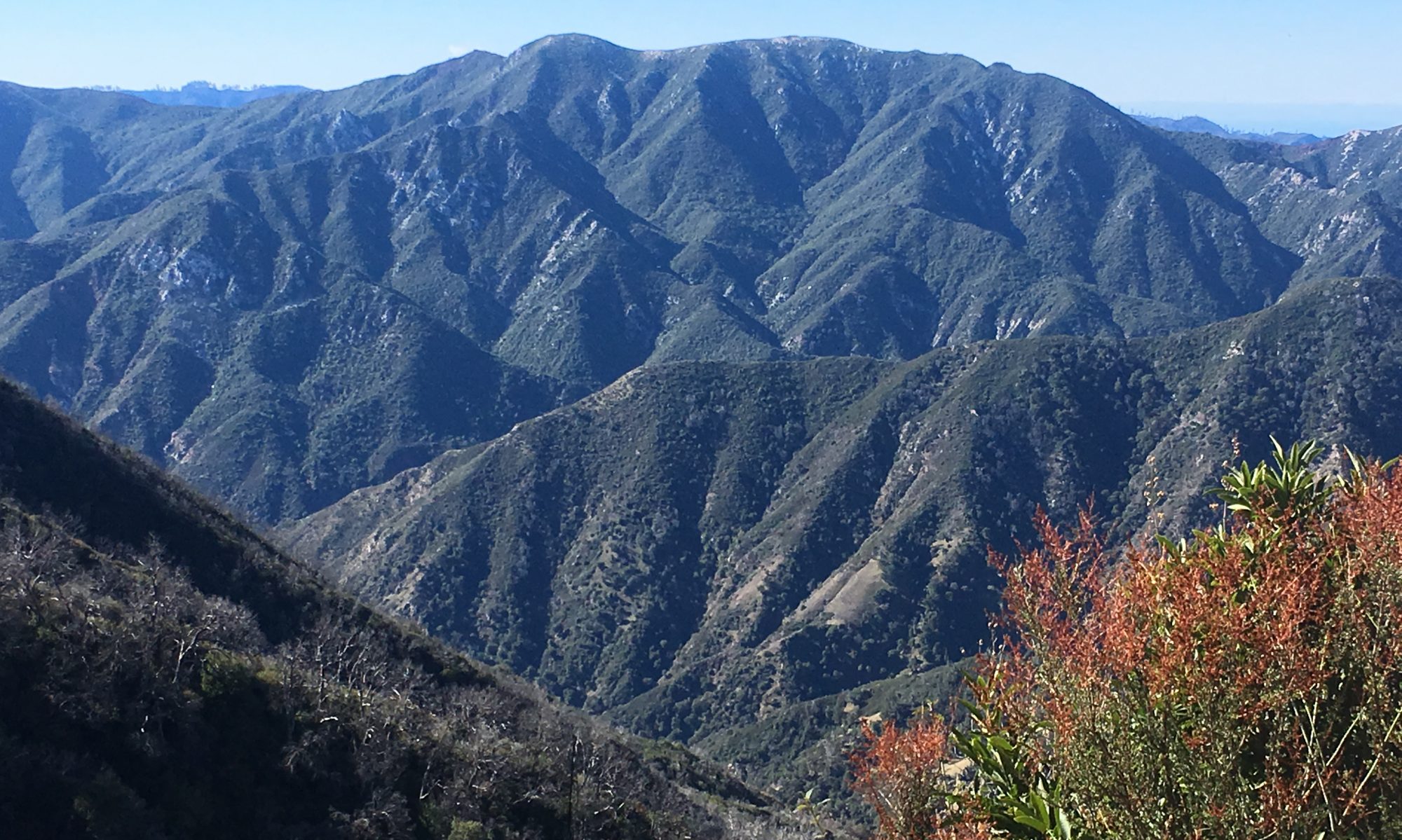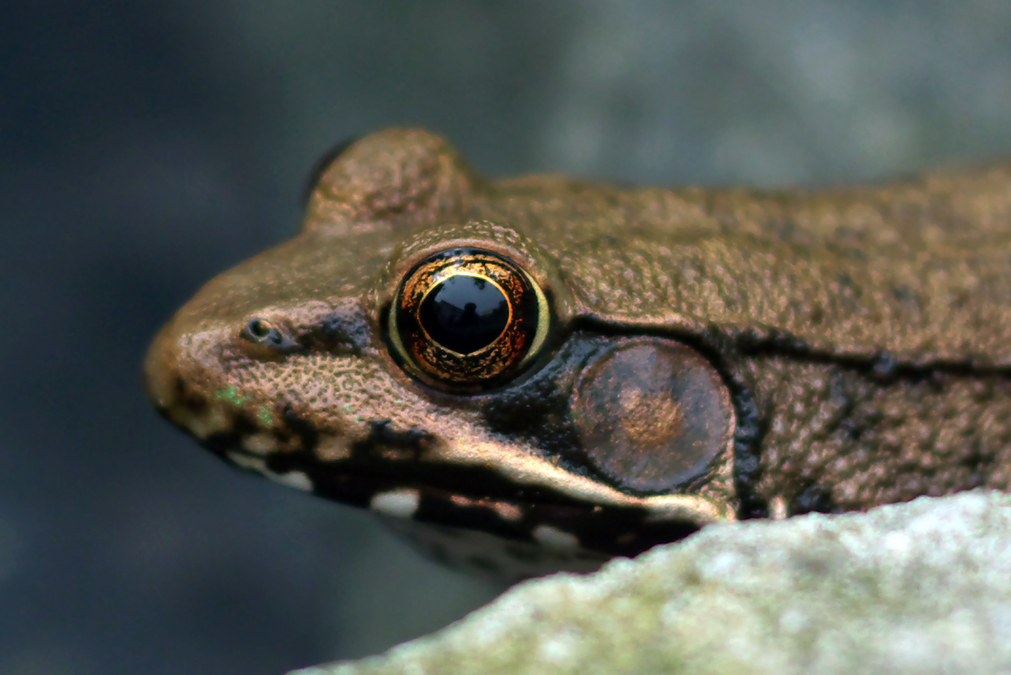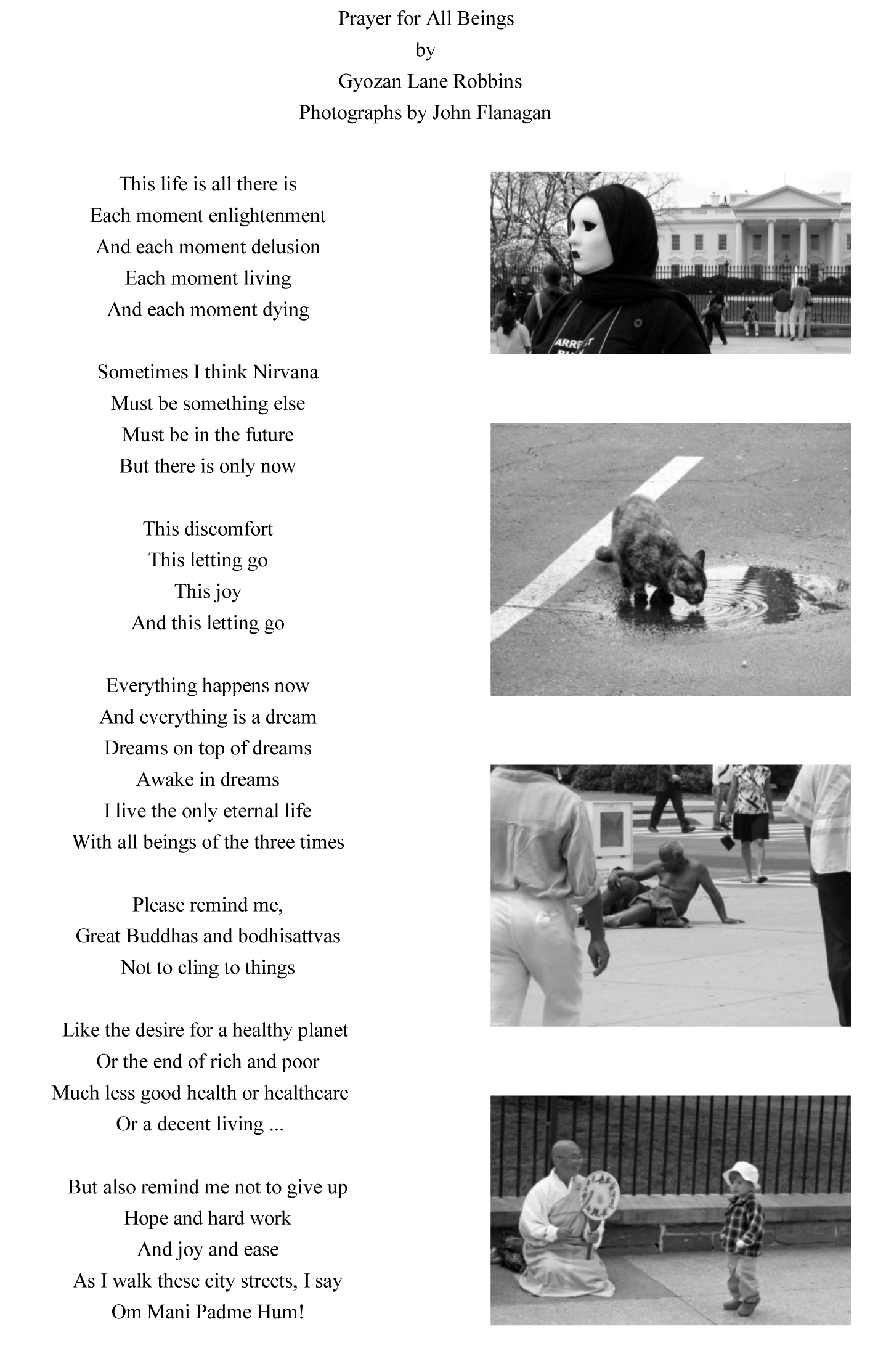Craig O’Brian writes on learning to make Enso’s at Green Gulch Farm during the 2019 All Beings Zen Sangha Private Practice Week
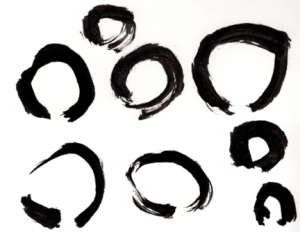
So we did the enso part of the practice in three stages. The first part was to draw lots of very small ensos, to get used to the motions and the ideas. I don’t know if the one on the top right counts as one stroke or two strokes. I was trying to do two strokes, but the brush left the page through part of the stroke.
The sort of center one (the second one in the second column) is I think my favorite of all the ensos I did that day. It’s got a nice weight to it. The inconsistency of the ink really shows the brush stroke well. And while it’s a little bit off from a true circle, it clearly contains a true circle. I’m going to try to make that the one that is the current icon of my web site.
Second Try
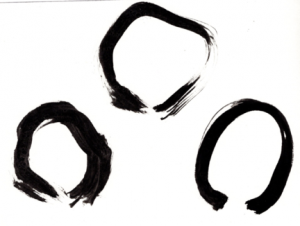
The second, larger set of ensos I drew.
The second set of ensos was done bigger, I guess to explore the form more. No, I don’t have the best memory of the workshop. I don’t have the best memory of anything, to be honest. I try to take notes, but it doesn’t seem very Zen.
I don’t like any of these. They’re way to sloppy, they are way off from being a circle, and while they are clearly brush strokes, I don’t think they express that very well. Or maybe they express poor brush strokes very well. However, I don’t think that makes them any less valid as ensos than my favorite one from the first set. They express the moment. I didn’t want a sloppy, poorly formed moment. But the moment doesn’t care what I wanted. There is nothing in that moment that could be called sloppiness or poor performance. If I think the moment was sloppy and poorly performed, that’s my problem.
Third Try
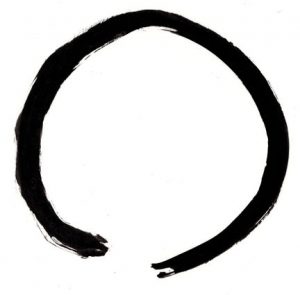
The final enso I drew at Green Gulch.
Finally, our teacher had us just draw one enso on a bigger section of the paper. I really took my time with this one. I waited with the brush above the paper until I felt a readiness to draw the enso. Then I did it slow and smooth, putting my whole arm into it. I’ve been getting back into drawing with pen and ink lately. I’m trying to take a more formal approach than just drawing random things like I did in my youth. It’s really brought home how doing something big requires the whole arm, not just the wrist and fingers… to read more click here.
Call to Artists for 2020 ABZS Calendar
Call to Artists! All Beings Zen Sangha is announcing a call to artists for the 2020 Sangha calendar project. Submissions are now being accepted for drawings, paintings, photography, poetry, and other forms of art and expression in digital format. Please submit up to three works for consideration by August 15, 2019 via e-mail to Inryu at inryubobbi@gmail.com or John at emailjohnf@gmail.com
Stay Calm and Keep Still – used with permission of mylittlebird.com

STILLNESS CAME to D.C. this January with 36 hours of snowfall.
“Snowzilla” stalled buses, planes, Metrorail and cars. Shops closed. People stayed home. Pets hunkered down.
It was quiet. It was calm.
Then, upon the sun’s return, the city of 700,000 had no choice but to stir.
Movement is inherent to life. Time and space are precious commodities in a city’s busy-ness.
Yet, one action, the snow reminds us, is always available: stilling.
“Stand still.”
This imperative begins the poem “Lost,” by David Wagoner.
“Wherever you are is called Here,” the speaker continues.
Stillness is an intentional pause to think, listen and notice the external world, to observe one’s internal state; it transforms our relationship with time and space and often ourselves. A moment of stillness is like a brief journey to another place.
“When the body is able to find some quiet,” explains Reverend Inryu of All Beings Zen community in Adams Morgan, “the mind has an opportunity to quiet down.”
Stillness is a precursor of meditation. One settles on a chair or on a cushion, organizing the skin, tissues, muscles and bones of the body to find a steady seat.
Even in the movement of walking meditation, a person cultivates a sense of internal stillness, clearing the sky of the mind. In group walking meditation, the custom is to take the pace of the most unhurried walker, voluntarily slowing. Notions of compassion and interconnection correlate with stillness. Inryu points out that all religions include contemplative practices for quiet retreat.
“Stillness has a lot of virtues,” agrees Washington, D.C., area bird watcher Nick Lund, who blogs at The Birdist, “and one of them is seeing how quickly everything else is moving. There’s a relativity there.”
We know that as long as we’re alive, we’re never truly still. However, by identifying gradations of movement, we increase awareness of ourselves and others.
“Birding is not particularly still in general,” Lund clarifies, “but when you’re in the woods, especially at this time of year when the woods can seem empty and quiet, you can just stop and close your eyes and be perfectly still and listen, and that’s when you start to pick up on how active everything else is. You start hearing birds and squirrels and all the other animals, people and dogs moving around.”
In a room, where meditators typically keep their eyes open, “being settled may open up a vantage to be more aware of what’s happening in the moment,” Inryu explains. “That can be a lot of activity, shifting sunlight or moonlight, shadows on the walls, the breathing and adjusting of people in the room.”
Inryu describes a quality of peace with our essential essence that comes from slowing down so completely. This peace allows us to be present.
“I think of being still as an opportunity to create conditions where you can be a human in your being aspect, rather than your doing aspect,” Inryu says.
Stilling transforms us from participants to observers. It’s as if we move off the playing field of modern human life to sit on the sidelines and observe the game. Whether noticing a thought or noticing a bird, we engage wholly.
“There’s beauty everywhere,” says Inryu, who has lived in D.C. for 23 years. She describes a flock of pigeons in a tree on Adams Mill Road that flew up all at once in a dance, like a murmuration of starlings.
“I even think of the exquisite beauty of people outside the Metro stations offering music,” she adds.
Attuning to the soundscape of the self and the city is a way to recognize the range of calm amid noise. Experiment with this by sitting or standing still for a minute or two for ambient sound meditation. Listen for sounds near and then farther and farther away. Notice the sounds without attaching to a single one. Then broaden and focus the awareness on sounds like turning the lens of a camera.
By pausing and listening, Lund saw something unexpected.
“I was trying to find a barred owl in Rock Creek Park on the last day of the year. I went up there around dusk and hung out and it was empty. It was quiet and cold, but I just stopped — one thing you can do with owls is stay still. I wasn’t moving, I wasn’t talking and I heard a rattling.”
He stayed still.
“I could tell it was a redheaded woodpecker and by just standing in that spot the bird came close and I was able to get a great look.That mindfulness and patience was rewarding. I didn’t see the bird I went out to see but I saw something surprising. I wouldn’t have seen it had I been trudging along.”
There’s a mutual benefit to being completely present with another. That “an-other” could be a person or a bird or even yourself. Stillness shelters a sense of whole-hearted attention on intimacy, on warmth, friendliness and an affinity for inhabiting a point in time.
For Lund, birding is a way to “slip into a calm and interesting mindset. It’s a hobby that fits me.”
For someone else, it might be listening to the tock of a grandfather clock, gazing at a painting, smelling the fragrance of simmering stew, floating in a swimming pool, sitting with a pet, gazing into the light of a candle, noticing the breath.
Identifying how you can still and what brings you peace is the key. Then, with practice, these attributes of stillness carry into actions as you move along life’s literal and figurative hectic roadways.
“I look forward to being shoved in a home somewhere and being able to sit quietly and look out a window at a bird feeder,” Lund says. “That would be a mental stillness, of a life pretty much over with, an unburdening that is involved in that and a time when you can devote time to your hobby. That’s a stillness that I’m looking forward to.”
— Alexa Mergen
Alexa Mergen teaches small group and private lessons in yoga, meditation and writing in Harpers Ferry, W.V. and Washington, D.C. and edits Yoga Stanza.
_____________________________________________________
For just a moment
Frog stops his constant croaking
And just looks around ——-John Flanagan
“You should be like a frog, always. That is true zazen.” —— Shunryu Suzuki-roshi
Photograph (c) John Flanagan
/////////////////////////////////////////////////////////////////////////////////////////////////////////////////////////
********************************************************************************
The empty cup
at the window
is filled
with light.
Poem and photograph by Sunyata Hrdaya (Alex Lima)
Zen has a long history of embracing and inspiring art. All Beings Zen Sangha is proud to display our member’s work with permission of the artists.
The photo that serves as the banner for our website was taken by our resident Priest, Rev. Inryu Bobbi Ponce-Barger
